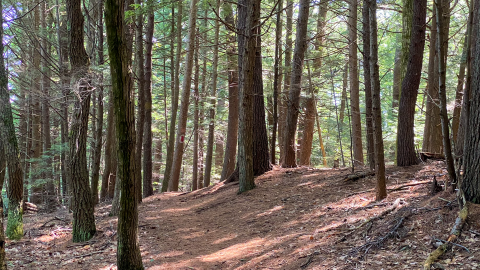
This fact sheet provides an overview of the requirements to qualify for the “forest land with documented stewardship” assessment. It is excerpted from the administrative rules of the current use law. For the entire law, rules, and informational handbook, contact the UNH Cooperative Extension Forestry Information Center at 1-800-444-8978 and request a copy of the Current Use Criteria Booklet or visit: http://revenue.nh.gov/current-use/booklets.htm
Forest land can be assessed in current use under one of two ranges of values: one which reflects the costs of land stewardship, or one which doesn’t. The assessment is lower in the documented stewardship category. The assessment ranges per acre are:
| Forest Type | Forest Land with Documented Stewardship | Forest Land |
| White Pine | $62-93 | $103-155 |
| Hardwood | $25-38 | $42-63 |
| All Other | $18-27 | $30-45 |
Assessment Ranges for Other Categories (per acre)
- Farmland: $25-425
- Unproductive: $18
- Wetland: $18
What the Rules Say
Landowners applying for documented stewardship shall submit Form A-10 accompanied by the following documentation at the time of application for open space assessment, and periodically thereafter at intervals of 5 or more years:
1. A statement of past forestry accomplishments, including an explanation of deviations from past plans submitted; and
2. An updated map; and
3. One of the following:
1. A letter from the New Hampshire Tree Farm Committee confirming certified tree farm status; or
2. A current certificate or equivalent, documenting the land’s conformance with the Sustainable Forestry Initiative Standard (SFI) or Forest Stewardship Council (FSC)-US Forest Management Standards; or
3. A forest stewardship plan signed by a forester licensed in New Hampshire, or a person exempted from licensure; and includes:
a. A statement of forest stewardship objectives;
b. Current forest stand descriptions;
c. Current management prescriptions that address timber; fish and wildlife habitat, soil, water quality, recreational resources, aesthetic values, cultural features, forest protection, wetlands, and threatened and endangered species and unique natural communities.
d. A boundary maintenance schedule
e. An access development and road maintenance plan, if applicable; or
4. A completed form CU-12, Summary of Forest Stewardship Plan for Current Use Assessment, (in lieu of submitting the entire plan), that includes a summary of all the information required above and is signed by the landowner and a forester licensed in New Hampshire. Landowners who don’t want to have a copy of their forest stewardship plan on file in their town office may want to use this form of documentation.
Getting Started
Meeting the requirements of the stewardship category will require some time on your part. UNH Cooperative Extension foresters or private foresters can assist you in this process. Financial assistance may be available to prepare a stewardship plan that will be more than adequate to meet the requirements of the current use law. To get started in developing a forest stewardship plan, learning more about forest stewardship and the Tree Farm program, or for additional information about current use assessment, contact your County Extension Forester. They can also refer you to private foresters in your area who can assist you.
Questions? Contact Staff Near You
Lindsay Watkins
lindsay.watkins@unh.edu
(603) 527-5475
Wendy Scribner
wendy.scribner@unh.edu
603-447-3834
12 Court Street, Keene, NH 03431
ce.cheshire@unh.edu
603-352-4550
Ray Berthiaume
ray.berthiaume@unh.edu
603-788-4961
James Frohn
jim.frohn@unh.edu
603-787-6944
Michael Gagnon
michael.gagnon@unh.edu
603-641-6060
Tim Fleury
tim.fleury@unh.edu
603-255-3733
Greg Jordan
greg.jordan@unh.edu
603-679-5616
Lindsay Watkins
lindsay.watkins@unh.edu
603-749-2529
Dode Gladders
dode.gladders@unh.edu
603-863-9200
Steven Roberge
steven.roberge@unh.edu
603-862-4861
forest.info@unh.edu
1-800-444-8978 within New England
603-862-3883
